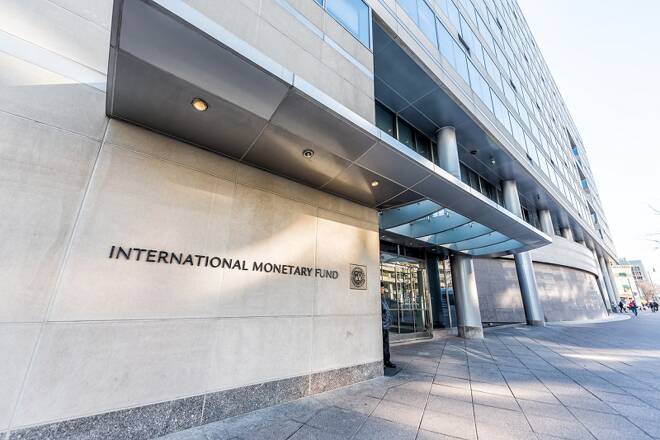Advertisement
Advertisement
COVID-19: The Latest Data From The Financial Markets
By:
Weekly themes with Dukascopy. There's certainly plenty to consider following the IMF's latest forecasts...
Let’s begin with the loudest headline of our time. The coronavirus continues to impact all aspects of life, and the global economy is no exception.
How is the battle against the virus going on, and what should traders expect from it?
Governments appear to be winning the battle on the virus front. A downward trend has continued in recent days. While we see the odd pickup, including one on Tuesday, we are definitely seeing the downward trend that supported appetite for riskier assets earlier in the week.
We’re not out of the woods just yet, however. China has reported a rise in new cases. These are from people returning from abroad. This raises questions over how long borders will remain closed, which brings doubts over a sharp economic rebound.
If you listen to the IMF, it’s likely to be far worse than many had priced in.
It is clear then that we continue to watch the infection numbers above all else. In the meantime, we leave macroeconomic data analysis in the background, as there is no point to look at historical data and create models for guidance in the current environment.
However, various data sets are clearly revealing the scale of the corona impact on various economies. There should have been numbers published that one has to know.
For sure, we aren’t interested in February stats from the EU, UK and the U.S. These economies weren’t hit until mid to late March, so looking at February figures will give very little away.
If we are looking at retail sales figures, we are going to need to look beyond March and April to assess the full extent damage. June and July stats will then reflect the effects of monetary and fiscal policy on countering the effects of the lockdown.
There are some numbers to look at. This week we have April manufacturing numbers out of the U.S. These will be much more interesting than March retail sales figures.
Chinese numbers seem suspicious to some market participants, as they draw a lot better picture than data from other parts of the world.
It could be possible for someone to compare the Chinese with other data sets throughout the week.
If the markets were reliant upon numbers out of China alone, then there would be no downside. We saw private sector PMIs rebound from historic lows to expansion within a month.
Then we saw March trade data also beat expectations, with the U.S Dollar trade surplus. There were less than expected falls in both imports and exports supporting a return to a surplus.
We will need to look at other numbers, however, to get a better picture of the economy.
Looking at trade figures across China’s key trading partners will give a better idea of how the recovery in the supply chain is progressing.
At the end of the week, we also have 1st quarter GDP numbers. When considering the IMF numbers, if these numbers don’t shock the markets then there will be some doubts over the numbers.
We’ve got retail sales and industrial production figures for March to also consider. Let’s not forget that the Chinese government is looking for domestic consumption to support a rebound.
So, Friday numbers and stats from key trading partners will need to be seen for a better picture…
If the US consumption has been mainly consisting of hoarding, sub-groups of the retail sales data should reveal it. Moreover, one could cut out the panic buying from the data and analyze the rest of the purchases of retail goods. Most likely various bank analysts will do that and publish their reports.
We’re expecting quite dire retail sales sides. We will see hoarding drive nondurable goods numbers but, with a surge in unemployment, there’s not going to be much spending…
The lockdown is meant to deliver the worst economic environment since the Great Depression.
Removing nondurable goods and looking at spending elsewhere is key and it should be dire.
Come April and even May, we could see even worse figures. We are seeing weekly claims of 6m, so there’s no spending other than on bare essentials.
As we move to a close, is there anything else that traders should watch out for.
Really, monitor the number of coronavirus numbers. Look out for any new clusters, particularly in any U.S states yet to be materially affected to date.
Obviously, a return to daily numbers that we saw earlier in Italy and other EU member states will also be a factor. We heard of reports from South Korea of people becoming infected for a 2nd time. Is that something that could hit the West?
There is always the possibility for a virus to mutate.
Initially, consider the day to day and ensure that there are no spikes.
Then consider the IMF forecasts from Tuesday and a global economic contraction of 3%. This dwarfs the contraction during the GFC. When considering a forecasted 6% contraction in the U.S and more than 7% in the Euro Area, the markets are being over-optimistic of a V-shaped rebound.
Looking at unemployment numbers, consumption is going to be slow to recover. That will weigh on manufacturers as well and, for now, the markets look far too bullish.
Being cautious of the downside would be my advice for now.
About the Author
Bob Masonauthor
With over 28 years of experience in the financial industry, Bob has worked with various global rating agencies and multinational banks. Currently he is covering currencies, commodities, alternative asset classes and global equities, focusing mostly on European and Asian markets.
Advertisement
